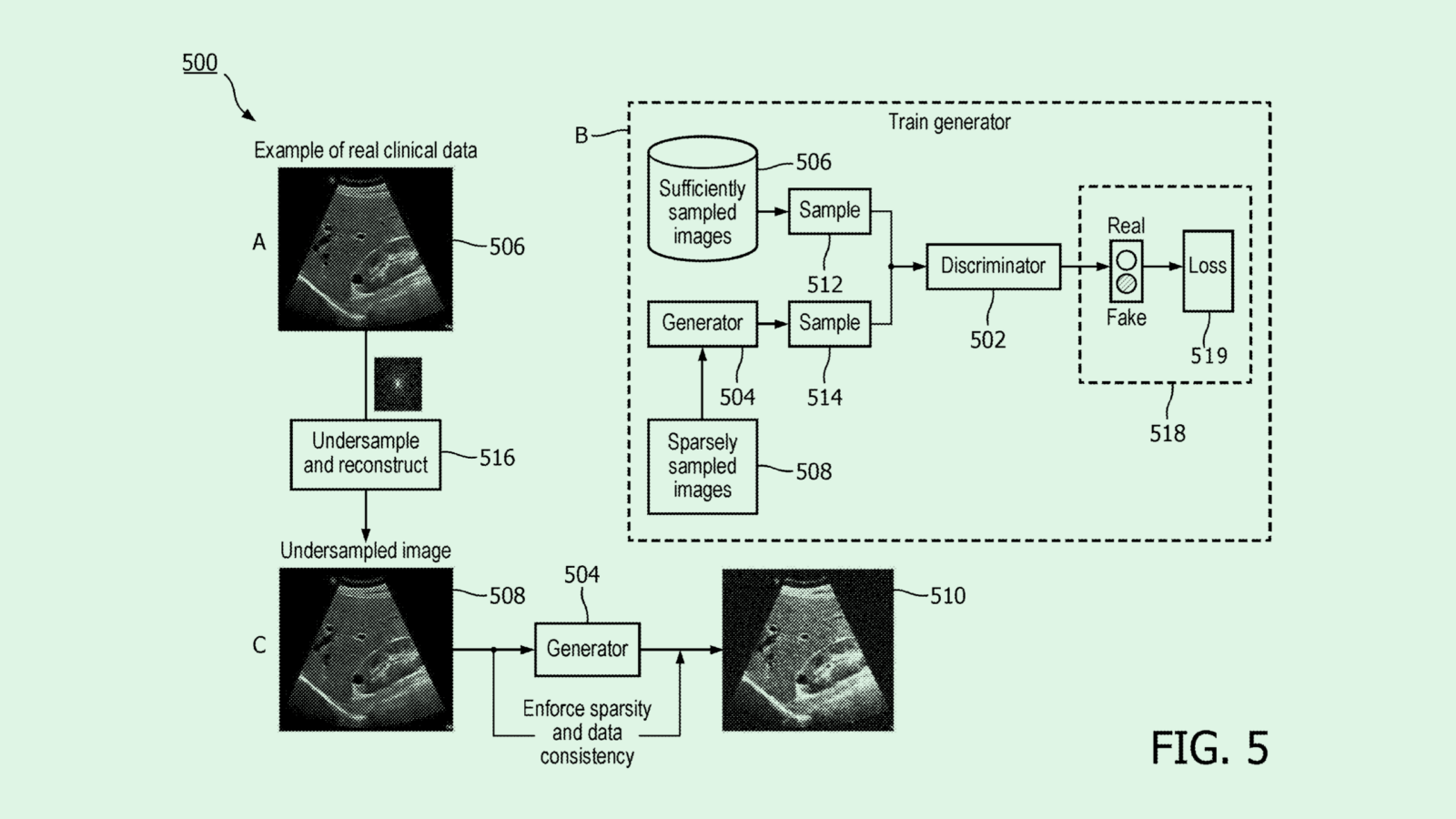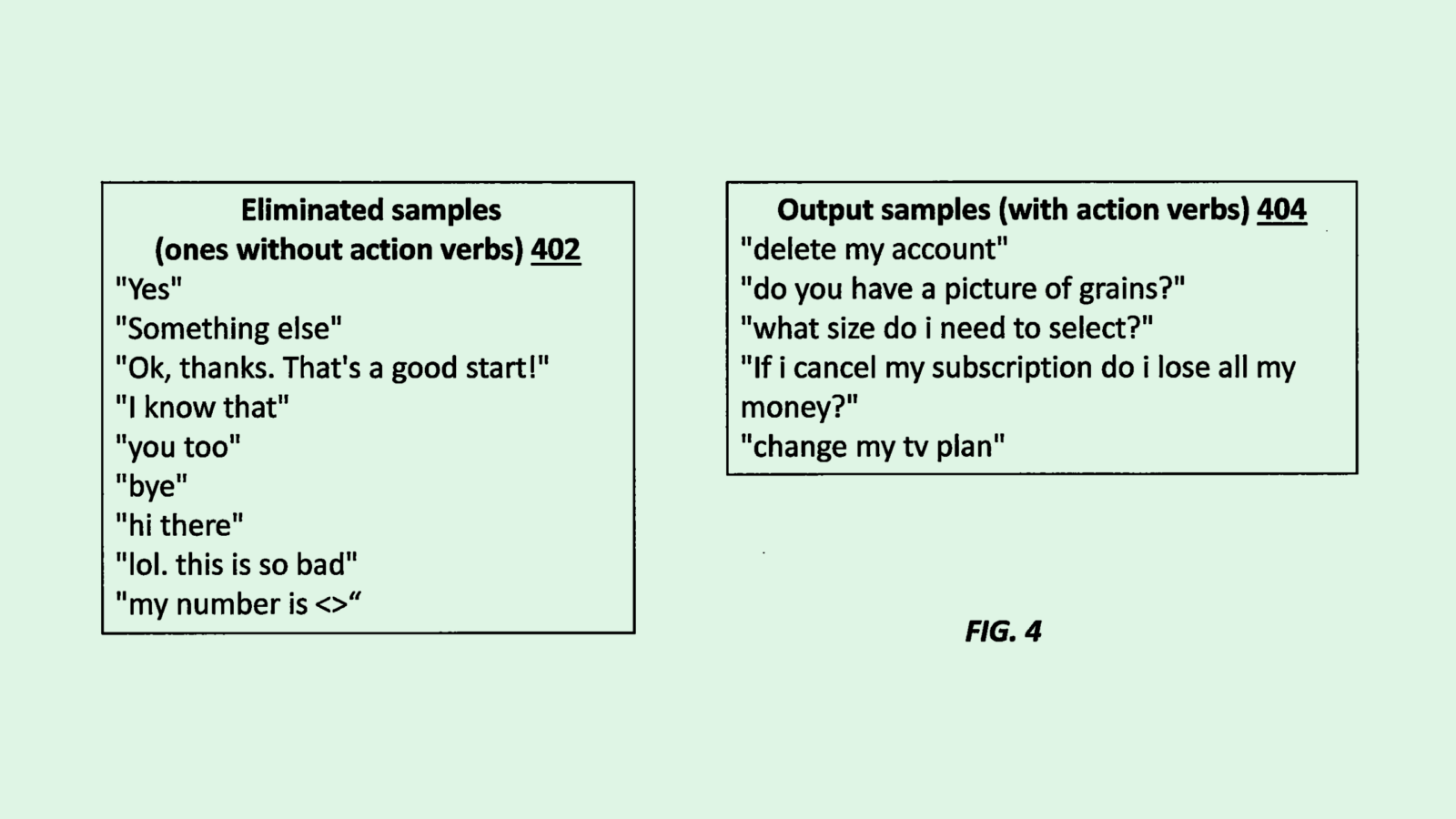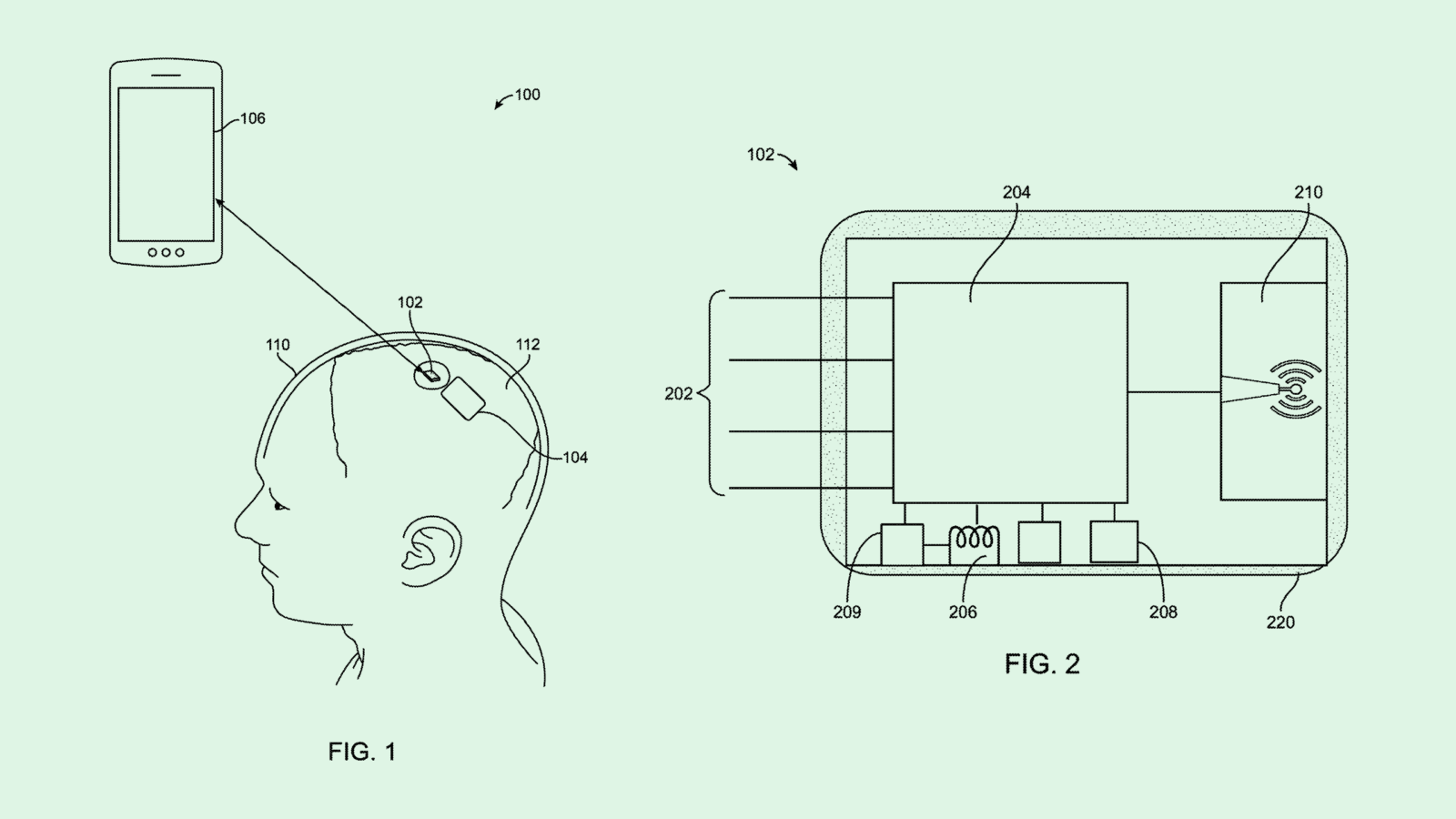Happy Thursday and welcome to Patent Drop!
Today, a patent for generative neural network-based ultrasounds from medical device firm Philips could provide more data to develop AI innovations throughout healthcare. Plus: Salesforce wants chatbots to expect the unexpected, and Neuralink wants to protect implants from interference.
Let’s check it out.
Philips’ AI Ultrasound
Philips may soon invite AI into the doctor’s office.
The medical devices firm filed a patent application for an ultrasound system that uses a neural network to produce images from “undersampled data.” To put it simply, Philips’ tech uses a generative neural network to create high-quality medical images despite incomplete data.
While similar techniques exist, they “may excessively smooth images, reduce speckle information, and/or introduce artifacts,” Philips said in the filing. “Some techniques for reconstructing images may be so computationally intensive that they cannot provide reconstructed images from undersampled data in real time or near real time, reducing their utility.”
The core of Philips’ tech relies on a neural network trained on fully sampled data (complete datasets) as well as undersampled data (partial datasets derived from the original fully-sampled data).
The model is trained to reconstruct entire images from the partial data and attempt to make the new images as realistic as possible. To put these images to the test, a “discriminator” will try to distinguish real images — those made from fully sampled data — from fake ones, generated by the neural network. The model then creates and improves the images until the discriminator can’t tell the difference.
Along with reducing false positives and negatives, Philips’ imaging system may “provide high quality images with diagnostic value” faster than conventional techniques, the company noted.

Philips’ patent is one example of how AI may play a growing role in the healthcare system. Whether it be diagnosis, imaging, drug discovery, recordkeeping, or note-taking, the ecosystem is ripe for AI innovation, said Dr. Ronald Razmi, co-founder and managing director of health tech-focused VC firm Zoi Capital.
However, data may stand in the way of these innovations, said Razmi. For one, AI commonly faces data-security issues, as these models can leak their training data simply by being fed certain prompts.
Plus, as it stands in the US, the Health Insurance Portability and Accountability Act, commonly known as HIPAA, places health data under lock and key, making training models used in healthcare all the more difficult.
“HIPAA is a pain in everybody’s neck when it comes to AI,” said Razmi. “It’s very necessary, because it’s protecting people’s privacy, it enforces companies that handle patient data to take security measures … but when it comes to the speed of innovation, data sharing, data pooling, and so forth, it definitely acts as a barrier.”
But synthetic data, as Philips’ patent seeks to create, may provide a solution to this issue, said Razmi. Because synthetic data is modeled on real data, but not representative of any individual patients, it provides an extra layer of protection, said Razmi. Synthetic data has been explored as a solution by several different tech firms, with Meta, Nvidia, IBM, and more seeking patents to put the tech to use.
“If you don’t have enough data to create a good algorithm, you can use what data you have to train AI to create new data, and you can train a better model,” said Razmi. “You can fill in the gaps.”
Salesforce Tests the Waters
Salesforce wants to make sure its AI models aren’t acting up.
The company filed a patent application for a way to provide an “automated testing pipeline for neural network models.” Salesforce’s tech allows developers to estimate whether or not their models will remain accurate when facing “unseen queries,” using a customer service bot as its primary example.
Typically, people will test their models using a portion of the data originally used in training, Salesforce said. “However, this evaluation procedure wouldn’t be an optimal estimate for smaller datasets or when real-time distribution varies significantly from the original training dataset distribution.”
To overcome this, Salesforce’s tech essentially curates both easy and hard evaluation datasets from real-time customer data to make sure the model can handle a diverse array of user queries. A hard evaluation dataset may use samples that are significantly different from what the model was trained on; an easy one would line up more closely.
This system passes customer data through several filters to create these datasets. First, it goes through a “dependency parser,” which identifies and filters specific actions or verbs that represent meaningful commands. Next, a pre-trained language model ranks the queries based on how similar they are to the data the model was trained on. A “bag of words” classifier then removes those queries, ensuring the testing data is sufficiently different from the original training data.
From this process, both the easy and hard datasets are created, and used to test the model’s capabilities. Salesforce also notes that this pipeline includes a “human-in-the-loop” feedback cycle to communicate when a model may not be performing up to par, which lets developers make adjustments.

Salesforce’s main AI offering is Einstein, its suite of solutions that allows customers to build generative AI experiences with their data. While other firms plunge their resources into building billion-parameter models, Salesforce’s strategy has been to teach a man to fish — the “man” being AI-hungry enterprise clients and the “fish” being the models themselves, said Bob Rogers, Ph.D., the co-founder of BeeKeeperAI and CEO of Oii.ai.
This patent could add another tool to that kit, ensuring the models created from its umbrella of offerings are working as intended — and well, said Rogers. “I think Salesforce wants Einstein to really generate more leads and faster. And if that’s not happening, and people are putting a lot of time and money into it, then that’s kind of a miss for Salesforce.”
With this patent, Rogers said, “I’m wondering if they were trying to get to a way to automatically help their customers not deploy bad models, because the self-service concept is a big core idea of Einstein.”
The filing’s focus on improving customer service chatbots may also hint at Salesforce’s interest in AI-based customer service interactions, said Rogers, especially as it unveiled its fully-autonomous Einstein Service Agent last week. “It says something about where Salesforce thinks the traction for Einstein may be going.”
But creating tools that allow people to build their own AI is “harder than it sounds,” said Rogers. And in a landscape crowded with companies like Google, Microsoft, and OpenAI that provide easy-to-use services, more often people rely on other models to do the hard work. “At the end of the day, most AI utilization is still people saying, ‘solve my problem for me,’” said Rogers.
Neuralink’s Brain Chip Protection Plan
Neuralink wants to make sure your brain doesn’t get hacked.
The startup filed a patent for “out-of-band pairing” for a wireless neural implant. Neuralink’s patent essentially details a way to pair a neural implant with an “external device,” such as a phone or computer, without falling victim to “man-in-the-middle attacks.”
A man-in-the-middle attack is a common security threat in which a bad actor intercepts or alters communication between two devices that are attempting to pair. “When transmitting data from the brain, or transmitting outputs from decoding neural data, security is particularly important,” Neuralink said in the filing.
First, an implant will receive signals from an external device, either from varying magnetic fields from the external device or via a set of neural signals. The implant then decodes these signals to identify a pairing code, used to authenticate both the external device and the implant.
The implant then performs what’s called a “key exchange” to ensure the pairing codes match; it either accepts or rejects the pairing based on this determination. This process also encrypts communication between the implant and the device, adding an extra layer of security.

After some back and forth with the Food and Drug Administration, Neuralink finally performed the first human trial of its brain-computer interface in January. Though Neuralink said in an April blog post that the procedure went well, some of the threads of the implant retracted from the patient’s brain. Despite the loose threads, the device is reportedly still functional.
The FDA has since cleared the way for the second trial, which CEO Elon Musk claimed in mid-July would be performed in the coming weeks. Neuralink is working on ways to mitigate the reaction that occurred in the first patient by sculpting the skull to minimize the gap between it and the implant, and potentially inserting threads deeper.
Though Neuralink’s testing is in its early days, Musk has ambitious goals for the startup’s tech, including restoring autonomy to those with “unmet medical needs” and treating conditions like depression and schizophrenia. He even mused on X recently that he thinks “cybernetic superpowers” are likely within reach. These ambitions have notched the company millions in funding last year: It secured a total of $323 million between two rounds. A recent Reuters report claims the company could be worth as much as $8 billion.
While Neuralink has made the most headlines, it’s not the only company working on brain chips: Synchron, a startup backed by funding from tech figureheads Bill Gates and Jeff Bezos, has implanted its devices in 10 people and opened a patient registry earlier this year. Precision Neuroscience, a startup founded by an ex-Neuralink executive, raised $41 million last year and deployed more than 4,000 electrodes in a patient’s brain in a successful study in May.
And though this technology is far from commonplace, patents like these may hint that Neuralink is trying to grab as much IP as it can in the nascent space as competition makes headway.
Extra Drops
- Amazon is learning sign language. The company filed a patent application for automated generation and presentation of “sign language avatars for video content.”
- Ford wants to automatically avoid collisions. The automaker is seeking to patent a system for “preventing interactions between (a) vehicle and a moving object.”
- Google wants to make sure your smart glasses fit right. The company filed a patent application for “fit detection” based on “metric features in image data” of wearable devices.
What Else is New?
- Coinbase’s UK unit was fined $4.5 million by regulators for breaching agreement to prevent the firm platform onboarding “high-risk” customers.
- Microsoft unveiled a Bing update that will prioritize AI-generated answers alongside traditional search results.
- Looking to Break Up the Day-to-Day News Cycle? Subscribe to the free Obsession newsletter from our friends at Quartz (who dig into the most interesting facets of a given topic). The Obsession allows you to diversify your news through fascinating, yet fun facts that can tell us where something came from and how it can change our lives. Obsess over the right stuff and subscribe here.*
* Partner
Patent Drop is written by Nat Rubio-Licht. You can find them on Twitter @natrubio__.
Patent Drop is a publication of The Daily Upside. For any questions or comments, feel free to contact us at patentdrop@thedailyupside.com.
